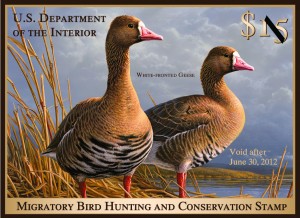The duck stamp. Most of us have one. If you’re 16 years old and want to hunt waterfowl legally you’d better have one. Take a spill in your boat, lose your wallet, and you may actually need to buy another. I’m speaking from experience here.
Whether your blind rests in a Missouri River slough or is tucked back on a bank of the Chesapeake Bay or along Utah’s Bear Lake, your duck stamp is advancing one of the country’s largest landscape-level conservation efforts. But it’s an effort that needs more attention and more support, quickly.
The Dakota Grassland Conservation Area is a project designed to accelerate the conservation of 240,000 acres of wetlands and 1.7 million acres of grasslands across the eastern portions of North and South Dakota. Often referred to as the Prairie Pothole Region (PPR), this is where mallards, pintails, shovelers, gadwalls, and blue-winged teal are made. This region supports nearly 30 percent of all breeding ducks in North America, as well as 200 different bird species.
“Whether you hunt the Mississippi flyway, the Missouri flyway or either coast, you need to care about conserving this landscape. It’s where your ducks come from,” says Lloyd Jones, currently with the US Fish and Wildlife and former director of North Dakota Game and Fish Department.
To date, landowners in North and South Dakota have enrolled more than 2.5 million acres of wetland and grassland in conservation easements under the Small Wetlands Acquisition Program (SWAP). Paid for with Duck Stamp dollars, SWAP promotes profitable farming and ranching, while conserving breeding habitat for wetland and grassland birds.
Despite SWAP’s success, it’s not moving quickly enough for conservation’s needs. The Dakota Grasslands Conservation Area would complement programs like SWAP by accessing another funding source, the Land and Water Conservation Fund. Why? Because currently there are 800 willing landowners, representing roughly 350,000 acres, standing in line for US Fish and Wildlife funding so they can enroll their lands in a conservation easement. In return, willing landowners commit to not alter the land beyond its current use by draining wetlands or plowing grasslands.
“Nobody’s leveling the Rocky Mountains or draining the Everglades,” says Jones. “But the Prairie Pothole Region is being lost. Accessing a new funding source to ramp up protection is critical.”
Across the conservation world, there is little argument that PPR is important. More than 30 groups, including Ducks Unlimited, Delta Waterfowl, Pheasants Forever, Boone & Crockett, Theodore Roosevelt Conservation Partnership, and Wildlife Management Institute, signed onto a letter to Department of Interior Secretary Salazar supporting the Dakota Grasslands Conservation Area.
John “Coop” Cooper is a former federal wildlife law enforcement agent and South Dakota Department of Game, Fish and Parks Secretary who has worked in the prairies for 40 years and still calls Pierre, South Dakota, home.
“The balance of working lands and conserved lands is part of South Dakota’s livelihood,” says Coop. “Pheasant hunting provides $200 million per year to our state, rural towns, and communities. But we’re on pace to lose 2.1 million acres of South Dakota’s CRP and 50 percent of the native prairie. The Dakota Grasslands Conservation Area will give landowners a wider set of choices to plan and implement their land goals without forgoing conservation.”
Enter funds from your duck stamp….
In 1989 the North American Wetlands Conservation Act (NAWCA) began providing matching US Fish and Wildlife Service funds for people and organizations to carryout wetlands conservation efforts. In the case of the Dakota Grasslands Conservation Area, the organization offering to match funds is Ducks Unlimited, at $50 million over 10 years.
But to realize these matches the US Fish and Wildlife Service needs the funding. These funds come from about one-half of the cost of a duck stamp. But as land prices have increased, duck stamps have held at $15 for the past 20 years. This lack of funding is leaving 800 willing landowners waiting on the sideline.
Steve Adair, director of the Ducks Unlimited Great Plains Regional Office in Bismarck, North Dakota, says, “DU’s members are ready to act in partnership with the US Fish and Wildlife Service and willing Prairie Pothole landowners to keep productive grasslands and wetlands on the landscape. But to do so we can’t let an opportunity like the Dakota Grassland Conservation Area pass us by. There just isn’t enough time.”
According to the US Fish and Wildlife Service, more than 800,000 upland and waterfowl hunters visit the Prairie Pothole Region each year. Whether you’re in that number or not, considering buying a duck stamp or two (and leave the extra one in your truck) to help make sure our nation’s duck and bird factory stays open for business.
To show support for the Dakota Grasslands Conservation Area, send an email to dgcacomments@fws.gov.
To read more great articles from Matt Wagner and many others go to www.thecontemporarywingshooter.com and subscribe for FREE!




